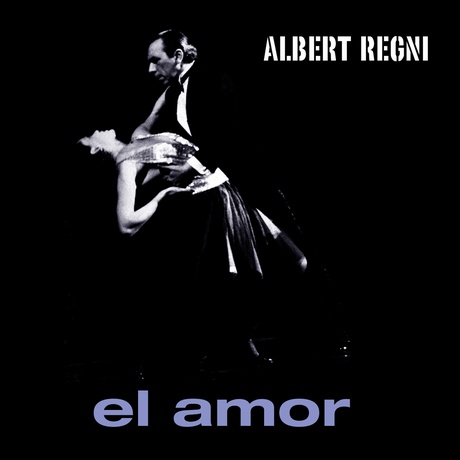
El Amor
Albert Regni

About
El Amor includes three suites inspired by dance rhythms to showcase the talents of Albert Regni, then principal saxophonist of the New York Philharmonic.
“El Amor” is one of the five atmospheric pieces by Astor Piazzolla included in the recording of the same name. All five pieces, heard in Regni’s own arrangements, are infused with the infectious rhythms of the tango. Pierre Max Dubois’ "Feu de Paille" (Straw Fire) sees the gavotte and other classic dances through an Impressionist lens, while Bernard Hoffer’s "Suite After Baroque Styles" evokes the world of Scarlatti, Bach, and Vivaldi.
Tracks
01 La Evasion 04:18
02 El Amor 04:31
03 Tango del Diablo 03:08
04 Oblivion 02:43
05 Todo Buenos Aires 04:44
Feu de Paille [Dubois]
06 Prélude et Gavotte 02:34
07 Fanfare et Final 04:03
Suite After Baroque Styles [Hoffer]
08 Arietta in a Bachian Manner 02:58
09 Scarlattian Sonata 03:43
10 Invention in a Baroque Style 05:47
11 Aria Maraisienne 04:27
12 Giga à la Vivaldi 03:06
Credits
Albert REGNI, soprano & alto saxophones
Marissa REGNI, violin
Shem GUIBBORY, violin
Ron CARBONE, viola
Maxine NEUMAN, cello
Eugene MOYE, cello
Notes
ASTOR PIAZZOLLA
My introduction to the music of Astor Piazzolla began in 1996 with a transcription of his "Histoire du Tango" by Claude Voirpy for saxophone quartet. I immediately felt its affinity for the instrument, along with the charm and breadth of its styles. The cosmopolitan flair and distinctive Argentine influence, combined with the harmonies of American jazz, have justly contributed to the composer’s worldwide popularity and success.
After a visit to Argentina that same year, I became familiar with Piazzolla’s published music and excitedly began making arrangements for saxophone with various combinations of instruments. In the pieces selected here, my intention was to reflect the saxophone’s compatibility with the string trio and the tango. Just as Piazzolla’s "Histoire du Tango" took the tango from clubs and bordellos to the concert hall, these arrangements are intended to be formally presented, for the ear rather than the feet.
"La Evasion" is a high-energy movement taken from a collection entitled Suite Lumiere (“Light”). The ‘evasion’ — of love? — is represented by a variety of agile, darting melodies in the saxophone and violin, along with a passionate, slow plea from the cello. "El Amor" presents a languid viola line as the underpinning of a Piazzolla melody (also from Suite Lumiere) soulfully yearning for love. "Tango del Diablo" has many of the sinister moods associated with a diabolical force. "Oblivion" stands as one of the most haunting, magical melodies of any musical style and makes one long to tango. Finally, "Todo Buenos Aires" represents the vitality and excitement of one of the world’s greatest cities.
— Albert Regni, May 1999
PIERRE MAX DUBOIS
"Feu de Paille" ("Straw Fire") is a colloquialism used in France to suggest a short, intense passion. The unusual combination of violin and saxophone displays Dubois’ crafty compositional skills, bringing together two instruments with remarkable technical and dynamic possibilities.
— Albert Regni, April 1999
BERNARD HOFFER
After a spirited dinner conversation on the advantages of playing cello or saxophone I was stimulated to write a piece for both instruments. I later presented "Invention in a Baroque Style" to Dorothy Glyde, the cellist, on the occasion of her 75th birthday. Later that year came "Scarlattian Sonata" for saxophonist Raymond Beckenstein, on his 70th birthday. This piece is for violin and soprano sax, both of which Ray plays. Finally, to round out the cycle, for Albert Regni’s 60th birthday came "Arietta in a Bachian Manner." I had thought about writing several more "birthday presents," but before the occasions could present themselves, Albert Regni planned a recital with string trio. I therefore wrote the other two pieces, "Aria Maraisienne" and "Giga à la Vivaldi," using all the string instruments to unify the suite. The compositions are written as stylistic paraphrases reminiscent of 17th- and 18th-century composers, though not specific to any one style.
— Bernard Hoffer, April 1999
ALBERT REGNI, the founder and leader of The American Saxophone Quartet, is Principal Saxophonist with the New York Philharmonic, Metropolitan Opera, and New York City Ballet Orchestras. He is also Professor of Saxophone at The College of New Jersey.
Reviews
"Albert Regni is the long-time sax star of the New York Philharmonic and other New York-based ensembles. His tone is very American, strong, extroverted, and adaptable, with technique second to none. This album sees him joined by several string players in a variety of pieces… as good as any [Piazzolla] I have heard… and Regni’s soprano sax swoons through them all, certainly as well as Ma… clever and idiomatic…."
~ American Record Guide, January/February 2000
"…this group of Piazzolla’s alluring melodies for the unlikely combination of soprano saxophone and string quartet… It appears to work very well… with Regni’s daughter, Marissa, given equal status in Pierre Max DuBois’s “Feu de Paille” (translated as “Straw Fire,” the title is a French colloquialism for intense passion). In two very short movements for saxophone and violin, the music has an improvisatory nature as the instruments combine and interact with a seductive fervor. One time winner of the Prix de Rome, this very fine French composer is all too neglected on disc, and, though brief, this addition is most welcome… Over the years Bernard Hoffer wrote a number of works… to form a delightful suite using a mixture of instruments, from a saxophone and violin duet, to a quartet for saxophone and three strings. This is fun music, immediately attractive, and with very catchy melodic content… The playing throughout is of the very highest quality…"
~ Fanfare, November/December 1999
